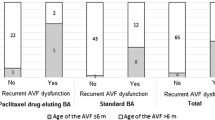Abstract
Purpose
To investigate the safety and effectiveness of lutonix paclitaxel-coated balloon (PCB) for the treatment of dysfunctional dialysis access.
Materials and Methods
This was a single-center, single-arm, retrospective analysis of 39 patients (23 male, 59 %) undergoing 61 interventions using 69 PCBs in a 20-month period. There was a balance between arteriovenous fistulae (AVF) and grafts (AVG) (20 AVFs, 19AVGs), and the majority of lesions were restenotic (25/39, 64.1 %). Mean balloon diameter used was 6.6 mm and length 73.4 mm. Primary outcome measure was target lesion primary patency (TLPP) at 6 months, while secondary outcome measures included factors affecting TLPP and major complications. As there were lesions treated more than once with PCB, authors also compared patency results after first and second PCB angioplasty.
Results
TLPP was 72.2 % at 6 months with a median patency of 260 days according to the Kaplan–Meier survival analysis. No major complications occurred. TLPP between AVFs and AVGs (311 vs. 237 days, respectively; p = 0.29) and de novo and restenotic lesions was similar (270.5 vs. 267.5 days, respectively; p = 0.50). In 14 cases, in which lesions were treated with two PCB angioplasties, a statistically significant difference in TLPP after the second treatment was noted (first intervention 179.5 days vs. second intervention 273.5 days; p = 0.032).
Conclusion
In this retrospective analysis, Lutonix PCB proved to be safe and effective in treating restenosis in dysfunctional dialysis access with results comparable to the literature available. Larger studies are needed to prove abovementioned results.





Similar content being viewed by others
References
Gilmore J. KDOQI clinical practice guidelines and clinical practice recommendations—2006 updates. Nephrol Nurs J. 2006;33(5):487–8.
Haskal ZJ, et al. Stent graft versus balloon angioplasty for failing dialysis-access grafts. N Engl J Med. 2010;362(6):494–503.
Diskin CJ. Novel insights into the pathobiology of the vascular access—do they translate into improved care? Blood Purif. 2010;29(2):216–29.
Karnabatidis D, et al. Stent-grafts versus angioplasty and/or bare metal stents for failing arteriovenous grafts: a cross-over longitudinal study. J Nephrol. 2013;26(2):389–95.
Haskal ZJ, et al. Prospective, randomized, concurrently-controlled study of a stent graft versus balloon angioplasty for treatment of arteriovenous access graft stenosis: 2-year results of the RENOVA study. J Vasc Interv Radiol. 2016;27(8):1105–14.
Shemesh D, et al. Angioplasty with stent graft versus bare stent for recurrent cephalic arch stenosis in autogenous arteriovenous access for hemodialysis: a prospective randomized clinical trial. J Vasc Surg. 2008;48(6):1524–31.
Kitrou PM, et al. Paclitaxel-coated versus plain balloon angioplasty for dysfunctional arteriovenous fistulae: 1-year results of a prospective randomized controlled trial. J Vasc Interv Radiol. 2015;26(3):348–54.
Kitrou PM, et al. Drug-eluting versus plain balloon angioplasty for the treatment of failing dialysis access: final results and cost-effectiveness analysis from a prospective randomized controlled trial (NCT01174472). Eur J Radiol. 2015;84(3):418–23.
Katsanos K, et al. Paclitaxel-coated balloon angioplasty vs. plain balloon dilation for the treatment of failing dialysis access: 6-month interim results from a prospective randomized controlled trial. J Endovasc Ther. 2012;19(2):263–72.
Lai CC, et al. Percutaneous angioplasty using a paclitaxel-coated balloon improves target lesion restenosis on inflow lesions of autogenous radiocephalic fistulas: a pilot study. J Vasc Interv Radiol. 2014;25(4):535–41.
Gray RJ, et al. Reporting standards for percutaneous interventions in dialysis access. Technology Assessment Committee. J Vasc Interv Radiol. 1999;10(10):1405–15.
Kitrou PM, Karnabatidis D, Katsanos K. Drug-coated balloons are replacing the need for nitinol stents in the superficial femoral artery. J Cardiovasc Surg (Torino). 2016.
Gray RJ, et al. Reporting standards for percutaneous interventions in dialysis access. J Vasc Interv Radiol. 2003;14(9 Pt 2):S433–42.
Karunanithy N, et al. Paclitaxel-coated balloon fistuloplasty versus plain balloon fistuloplasty only to preserve the patency of arteriovenous fistulae used for haemodialysis (PAVE): study protocol for a randomised controlled trial. Trials. 2016;17(1):241.
Patane D, et al. Drug-eluting balloon for the treatment of failing hemodialytic radiocephalic arteriovenous fistulas: our experience in the treatment of juxta-anastomotic stenoses. J Vasc Access. 2014;15(5):338–43.
Massmann A, et al. Paclitaxel-coated balloon angioplasty for symptomatic central vein restenosis in patients with hemodialysis fistulas. J Endovasc Ther. 2015;22(1):74–9.
Author information
Authors and Affiliations
Corresponding author
Ethics declarations
Conflict of interest
The authors would like to state that there is no financial arrangement or other relationship that could be construed as a conflict of interest. Stavros Spiliopoulos has received consultancy fees from MEDTRONIC. Konstantinos Katsanos has received travel sponsorship and lecture honoraria by MEDTRONIC and BOSTON SCIENTIFIC. Dimitrios Karnabatidis has received consultancy fees from MEDTRONIC, BARD and BOSTON SCIENTIFIC.
Rights and permissions
About this article
Cite this article
Kitrou, P.M., Spiliopoulos, S., Papadimatos, P. et al. Paclitaxel-Coated Balloons for the Treatment of Dysfunctional Dialysis Access. Results from a Single-Center, Retrospective Analysis. Cardiovasc Intervent Radiol 40, 50–54 (2017). https://doi.org/10.1007/s00270-016-1479-y
Received:
Accepted:
Published:
Issue Date:
DOI: https://doi.org/10.1007/s00270-016-1479-y




